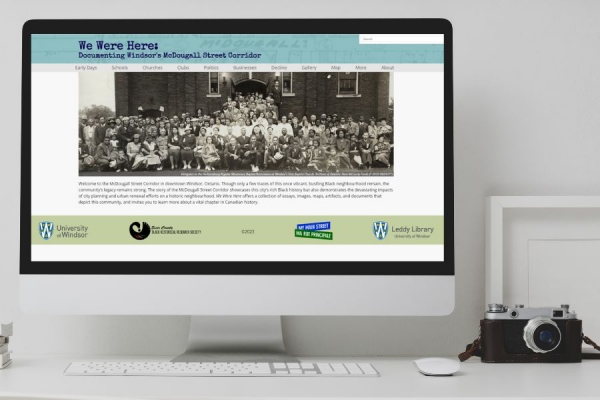 The digital archive “We Were Here” documents the history of Windsor’s McDougall Street corridor.
The digital archive “We Were Here” documents the history of Windsor’s McDougall Street corridor.
A new resource of the Leddy Library aims to recover the stories of Windsor’s McDougall Street corridor, a once vibrant and bustling Black neighbourhood in the city’s downtown. The neighbourhood which stretches from Goyeau Street to Highland Avenue and between Pitt Street and Giles Boulevard, was once filled with businesses, schools, and churches.
Only a few traces of the community remain after urban redevelopment in the 1950s moved people out of the neighbourhood homes and businesses. Willow Key, master’s student in history, was eager to ensure those remaining traces would not be lost.
Keen to preserve the stories and history, she reached out to members of the community to conduct interviews and gather ephemera.
“My research interests have always involved Black Canadian history and through this opportunity of sharing the McDougall Street corridor’s history with the public, I also discovered my own family’s connection to the neighbourhood,” said Key.
The preliminary research was funded through the UWindsor Anti-Black Racism Student Leadership Experience Grant program. Key worked with Leddy Library’s digital scholarship librarian Heidi Jacobs and archivist Sarah Glassford, and Irene Moore Davis of the Essex County Black Historical Research Society, to collect the stories of the community hub for Black families in Windsor.
“Participating in the Anti-Black Racism Student Leadership Experience program and getting to work with Willow has been a phenomenal experience for all of us at Leddy Library,” said Dr. Jacobs. “Willow is a strong researcher and this program allowed her to take her skills to the next level, as well as develop a network of community relationships, and professional mentors.”
The story of the McDougall Street corridor showcases this city’s rich Black history but also demonstrates the devastating impacts of city planning and urban renewal efforts on the community. We Were Here offers a collection of essays, images, maps, artifacts, and documents, and invites you to learn more about a vital chapter in Canadian history.
“This project brings together images and documents you won’t find in any other single place, because they are held in a combination of private family collections and geographically dispersed public archives,” said Glassford. “Digitizing and curating them for this project is a way to give the tangible evidence of the McDougall Street corridor’s history back to the community itself, in virtual form, even as the original documents remain safely preserved in their respective homes.”
The project, which is now available online, aims to preserve the legacy of the community.
With the research and digital exhibit complete, Key says the project will continue to evolve. Plans for a mobile app funded by FedDevOntario and MyMainStreet grants are underway that will encourage pedestrian engagement with the community’s history by using street signage to connect them with the app for self-guided historical tours. Directed by Anneke Smit of the Windsor Law Centre for Cities, the project team will launch the mobile app and walking tour in April.
“The stories and memories shared throughout this project offer a unique glimpse into the history of Windsor’s downtown Black community and the impact of postwar urban renewal,” said Key. “There is so much more to share with the public about this historic neighbourhood and I would love to eventually write a book.”
For more information, visit the We Were Here: Documenting Windsor’s McDougall Street Corridor digital archive.
—Marcie Demmans
